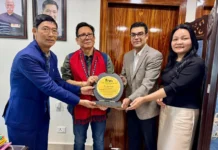Monday Musing
[ Ajum ]
Once considered to be the most difficult district to live in and travel to, Dibang Valley is the new big thing in Arunachal’s tourism circuit. Due to poor road and mobile communication, government officials used to dread when they were transferred to the district. The politicians used to transfer government officials who did not vote for them to the district as a kind of punishment posting.
I had travelled to Anini, the headquarters of Dibang Valley, in 2011 with the then governor JJ Singh. However, it was a chopper ride and I did not get the opportunity to explore the district in the true sense. Last month, I along with a group of friends and relatives set out on a tour to Dibang Valley to trek the famous 7 Lakes situated in the Idu Mishmi Hills. This was the first time that I was travelling by road, and I had heard of how bad the road’s condition was between Lower Dibang Valley HQ Roing and Anini. However, much to my surprise, the two-lane highway being constructed between the two districts’ headquarters has progressed much. The drive, especially in between Hunli and Anini, was pleasant. There are some stretches where the condition of the road is still dangerous. However, once the two-lane highway is completed, the drive between Roing and Anini will be pleasant. Maybe the rich boys from Mumbai will next time take their supercars to Anini.
The 7 Lakes trekking itself was an experience of a lifetime. Trekking for eight days at heights of 13,000 to 14,000 feet above sea level was challenging. With no connection with the rest of the world, especially for people like us, who are so used to a lazy town lifestyle, it was tough. The trek was organized by the Emudu seven lakes trekkers group, which is a registered NGO. It started officially operating in October 2020. The trekking is organized by mainly six persons, namely, Sajani Mipi, Manish Milli, Noven Rondo, Kanki Miri, Ajadi Rondo, and Jimu Mele. All of them are local Idu Mishmi tribesmen. The parents of some of them used to once hunt in the 7 Lakes trekking route, due to which they came to know about its existence.
Without any support from the government agencies, they have successfully launched this trekking route. They have established trekking routes and basic infrastructures for camping from their own resources.
At a time when youths of the state are busy looking for easy money without doing hard work, the efforts of the Emudu trekkers truly deserve appreciation. Trekking enthusiasts from across the country come to Anini to trek to the 7 Lakes. In fact, this trekking route is more popular among the mainland Indians than among the Arunachalees.
The best part about the Emudu 7 Lakes trekking is that it employs many local youths directly and indirectly. “We have employed more than 40 different porters. Trekkers use local markets, local Sumo drivers, homestays in Anini and Roing. This way this trek is generating employment opportunity and boosting the local economy,” said Jimu Mele, one of the members of the Emudu seven lakes trekkers. The team wants to further explore more areas and truly develop Dibang Valley as a hub of trekking activities in the future.
“We have a plan to develop Mathu valley for winter trek, starting December 2022. After that, we also plan to develop Maliney and Dri valley treks. It will create job opportunities for more than 100 local youths and also improve the economy for homestay owners, local vendors and local markets,” said Jimu.
The 7 Lakes trekking season starts in June and ends by October. During winter it remains closed due to heavy snowfall. All the seven lakes are stunningly beautiful. The Emudu 7 Lakes trek organizers are quite professional, even though they say that they are still learning the nitty-gritty of the tourism industry. If any person cannot complete a trek due to health reasons, they carry the person on their back up to the road. Littering with plastic waste is strictly prohibited and trekkers have to strictly comply with the local tradition and beliefs.




